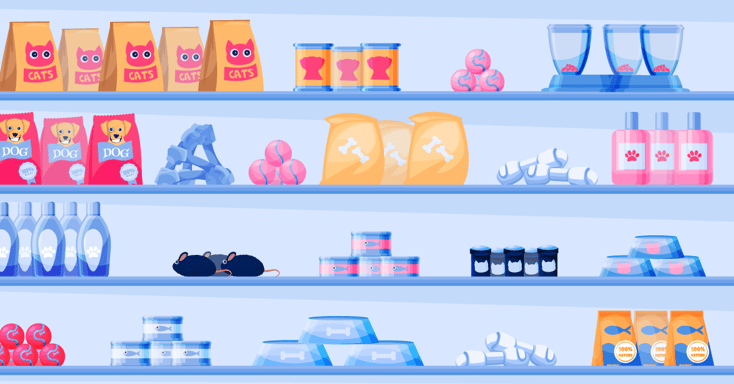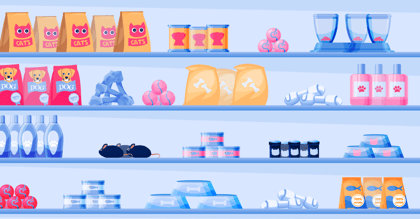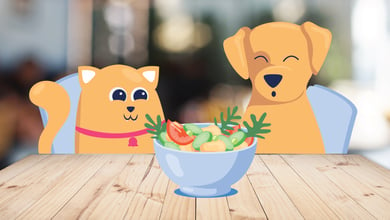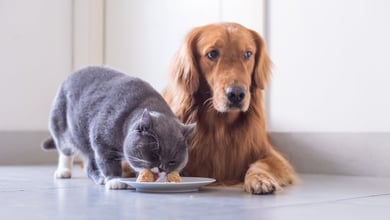5 Cat Food Ingredients to Look For & Ones to Avoid

Table of Contents
Navigating the maze of cat food ingredients can be a daunting task for even the most dedicated pet parent.
But don't worry, you're not alone in this quest for feline dietary excellence!
This comprehensive guide, created by an experienced vet, is here to demystify what's inside that can or bag of cat food. We'll explore the essential components for a healthy diet, uncover the best ingredients to look for, and highlight some you should steer clear of.
It's time to unravel the complex world of cat nutrition so that you can make informed decisions for your feline friend's well-being.
Here's the 5 most important cat food ingredients owners should look for:
1. Proteins
Cats are obligate carnivores, meaning they need a source of dietary protein to thrive. Protein is a crucial component of every cat's diet, providing essential amino acids necessary for the growth and repair of body tissues, including muscles, organs, skin, hair, and nails.
When choosing a cat food, the source of the protein is just as important as the quantity. Named protein should be listed as one of the first ingredients on the food label. A named protein source indicates that the protein is coming from a reputable source rather than a mix of various unknown meats.
Look for high-quality, named animal proteins such as:
- Chicken
- Turkey
- Beef
- Lamb
- Fish
- Organ meats
How Much Protein Should be in Cat Food?
According to the AAFCO, cat food should contain a minimum of 26% to 30% crude protein by dry matter for growth and reproduction. Cat food containing this ratio is considered to be nutritionally complete and balanced.
The Impact of the Amino Acid Taurine for Cats
One unique aspect of feline nutrition is their need for the amino acid taurine. Unlike dogs and humans, cats cannot synthesize taurine from other amino acids, so they must get it directly from their diet.
A taurine deficiency can lead to serious health issues in cats, including heart disease and blindness. Taurine is found naturally in meat, especially organ meats like heart and liver. Thus, a cat food rich in named meat sources is not only a good source of protein but also of essential taurine.
2. Fats and Oils
Fats are the most concentrated form of energy for cats, providing more than twice the energy per gram compared to proteins or carbohydrates.
Omega-3 and Omega-6 fatty acids play crucial roles in overall health, including skin and coat health, brain function, vision, and anti-inflammatory processes. Cats cannot produce these fatty acids in their body, so they need to be present in their diet.
Essential fatty acids in cat food include:
- Arachidonic acid
- Linoleic acid
- DHA (docosahexaenoic acid)
These are particularly important for cats because they cannot be synthesized in the body and must come from the diet.
Animal-based fats are typically more readily utilized by cats than plant-based fats. Common sources of animal fats in cat food include: chicken fat, salmon oil, and fish oil concentrates.
Some plant-based fats, like flaxseed or canola oil, can also be found in cat food, but they don't provide all the essential fatty acids a cat needs.
How Much Fat Should be in Cat Food?
Cat food should contain a fat content of roughly 9% of dry matter. Too much fat can lead to obesity, while too little can lead to nutritional deficiencies, especially in kittens who need fats for proper growth and development.
Fat content in cat food can vary widely, and not all fats are created equal. Look for cat food that lists specific sources of fats and oils, such as named animal fats (e.g., chicken fat, salmon oil), instead of generic terms like "animal fat".
3. Carbohydrates
Unlike dogs and humans, cats have no nutritional requirement for carbohydrates in their diet. Their natural diet – small prey animals – contains very few carbohydrates.
Cats have adapted to this meat-rich, low-carb diet, and as a result, they utilize protein and fats more efficiently than carbs for energy.
That said, some amount of digestible carbohydrate can be utilized by cats for energy.
Carbs in cat food can come from a variety of sources, including:
- Grains like corn, wheat, and rice
- Grain-free sources like potatoes, peas, and lentils.
How Much Carbohydrates Should be in Cat Food?
While some carbohydrates can be beneficial for the fiber they provide, many experts recommend that cat food should not exceed 10% carbohydrate content on a dry matter basis.
A high-carbohydrate diet is not ideal for cats and can contribute to obesity and related health issues, particularly in less active, indoor cats.
This is because cats lack certain enzymes that other species use to process carbohydrates, leading to a more rapid and drastic increase in blood sugar levels when they eat carbs. Over time, this can stress the cat's body and lead to health issues like obesity and diabetes.
4. Fiber
Despite the carnivorous nature of cats, dietary fiber plays an important role in their overall gut health and digestion.
Fiber helps to add bulk to the diet, which can aid in controlling weight by promoting a feeling of fullness without adding too many calories. It also aids in digestion by helping to move food through the digestive tract, which can assist in the prevention of constipation and help with hairball control.
There are two main types of fiber in cat food: soluble and insoluble.
- Soluble fiber dissolves in water and can be fermented by the bacteria in the cat's gut. This type of fiber can help to moderate glucose absorption and improve overall digestive health.
- Insoluble fiber, on the other hand, does not dissolve in water and adds bulk to the stool, helping to keep the digestive system moving properly.
Common sources of fiber in cat food include:
- Beet pulp
- Cellulose
- Psyllium husk
- Fruits and vegetables
How Much Fiber Should be in Cat Food?
The optimal level of fiber for cats is typically considered to be around 3-5% on a dry matter basis, though this may vary depending on the individual cat and their specific health concerns.
While some fiber is beneficial, too much can interfere with the absorption of nutrients and can lead to loose stools or diarrhea.
5. Vitamins and Minerals
Vitamins and minerals are essential nutrients that play numerous roles in your cat's body, from supporting bone health to aiding in energy production. They are involved in tissue growth and repair, maintaining a healthy immune system, bone structure, nerve conduction, muscle contraction, blood clotting, and they aid enzymes in metabolic reactions.
Some of the essential vitamins for cats include A, D, E, and K, as well as several B-vitamins.
Cats also need a variety of minerals such as:
- Calcium and phosphorus for bone health
- Iron for red blood cell production
- Zinc for skin health and immune function
Minerals like potassium, sodium, and chloride are also vital for fluid balance and nerve transmission.
Many commercial cat foods are fortified with synthetic vitamins and minerals to ensure that they meet the necessary nutritional standards. However, high-quality cat foods will also use natural ingredients that are high in these nutrients.
Ingredients to Avoid in Cat Food
When selecting cat food, there are certain ingredients you should strive to avoid, as they might be harmful to your feline friend.
These are some of the ingredients cat owners should avoid when choosing cat food:
1. Animal By-Products
Animal by-products often contain low-quality parts of animals that are not typically consumed by humans, like bones, blood, heads, and feet. While not all by-products are harmful, their nutritional content can vary significantly.
Whenever possible, look for foods that specify the sources of their ingredients (e.g., chicken or beef) instead of vague terms like "meat by-products."
2. Grains and Fillers
Cats are obligate carnivores and have a limited ability to digest grains. Foods with corn, wheat, or soy as the primary ingredients might not provide the right nutrition for your cat.
These ingredients are often used as cheap fillers to bulk up the food but offer little nutritional value.
3. Artificial Colors, Flavors, and Preservatives
Just like in human food, artificial additives in cat food can potentially lead to health problems. Some to watch out for include BHA, BHT, ethoxyquin, artificial colors, and propylene glycol.
4. Added Sugars
Cats do not need sugar in their diet, and too much can lead to obesity and other health problems. Look out for ingredients like corn syrup, which is essentially added sugar.
5. Rendered Fats
These are often used for flavor, but they can also promote bacterial growth and contain toxins. Instead, look for specified fat sources like chicken fat.
Wet Cat Food vs Dry Cat Food
Both dry and wet cat food have their own advantages, and many veterinarians recommend a mix of both.
Wet Cat Food
-
Hydration: Wet cat food has a high moisture content, which helps keep cats well-hydrated and can be especially beneficial for cats who don't drink enough water.
-
Protein content: Wet food often contains more animal-based protein, which aligns with a cat's natural diet as an obligate carnivore.
-
Easier to eat: For older cats or cats with dental issues, wet food can be easier to chew and swallow.
Dry Cat Food
-
Dental health: Dry cat food can help remove plaque and tartar from a cat's teeth, promoting better oral health.
-
Convenience: Dry food is non-perishable, can be left out for free-feeding without spoiling, and is easy to store and measure.
-
Cost: Dry food is often more affordable than wet food and can be more cost-effective for feeding multiple cats.
It's important to remember that every cat is different, and what works well for one might not work for another. The best approach often depends on the cat's age, health status, lifestyle, and personal preferences. Consulting with your veterinarian is the best way to determine the most suitable diet for your cat.
Frequently Asked Questions
Can cats be vegan or vegetarian?
Cats are obligate carnivores. They require specific nutrients, like taurine and arachidonic acid, that are found only in animal sources. Thus, a vegetarian or vegan diet is not recommended for cats.
Are raw diets better for my cat?
Raw diets can provide cats with high-quality, unprocessed protein. However, they also pose risks, including potential for bacterial contamination and nutrient imbalances. It's crucial to discuss with a vet before switching your cat to a raw diet.
Are certain breeds allergic to specific ingredients?
Food allergies in cats are not breed-specific; any cat can develop a food allergy. Common allergens include beef, fish, dairy, and grain. if you're unsure of what food your cat is allergic too, a comprehensive allergy and dermatologic exam can help.
Why is taurine so important for cats?
Taurine is an essential amino acid for cats, necessary for heart and eye health. Unlike other animals, cats cannot produce their own taurine and must get it from their diet.
What should be the first ingredient in my cat's food?
The first ingredient in cat food should be a high-quality source of animal protein, such as chicken, beef, or fish.
Can cats have food allergies?
Yes, cats can have food allergies, which often manifest as skin irritations, vomiting, or diarrhea.
Is it okay to feed my cat dog food?
No, it's not okay to feed your cat dog food. Cats have different nutritional needs than dogs and require certain nutrients, like taurine, that are not present in dog food.
Why is moisture content important in cat food?
Moisture content is crucial in cat food because cats often get a significant portion of their water intake from their food. Wet cat food can be particularly beneficial for cats prone to urinary or kidney problems.
Should you feed your cat wet or dry food?
Our experienced veterinarians suggest a mix of wet and dry food. Doing so will provide your cat with the benefits of each, such as the moisture and ease of digestion of wet food and the dental benefits of dry food.
Understanding Cat Food Ingredients
In conclusion, feeding your feline friend a balanced diet packed with quality ingredients is key to their overall health and longevity.
Look for cat food with high-quality protein sources, necessary fats, minimal carbohydrates, a balanced mix of fiber, and the right vitamins and minerals.
Avoid foods with harmful additives, fillers, or allergenic ingredients. While the world of cat food can seem overwhelming, a good understanding of what to look for and what to avoid can make all the difference.
As always, your veterinarian is a valuable resource for personalized advice about your cat's nutritional needs. Remember, your cat's diet directly influences their health and happiness.






